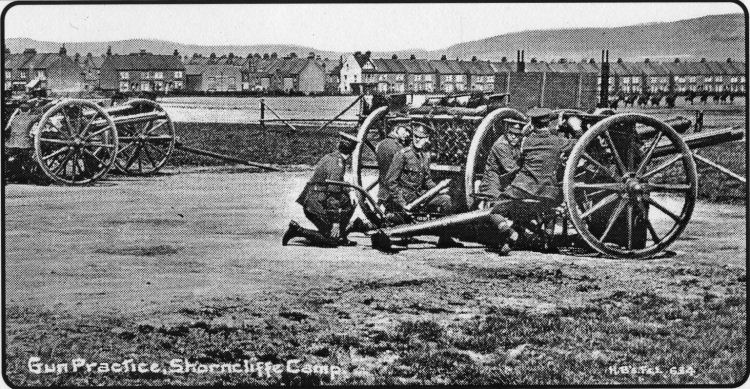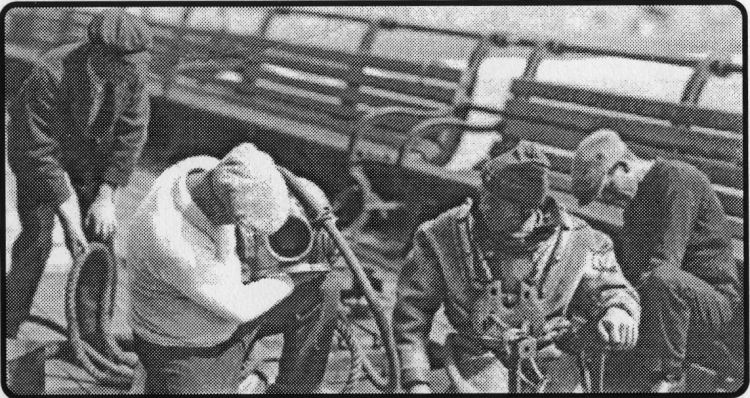
Published 2 May 2002
Note from Bob. Right to Left Pace is on the left.

Surprise!
IT IS always nice to know that an article or picture used in Memories
created interest or gave a reader a pleasant surprise. An early picture of a
diver, preparing to put on a show on the old Victoria Pier at Folkestone,
which was used recently proved of special interest to two cousins, Mrs
Christine Taylor, of Norfolk, and Mrs Susanne Pilcher, of Folkestone.
The photograph (bottom right) was shown to me by Alan Taylor, Chairman of
the Folkestone Local History Society.
Christine told me "The man on the left was our grandad, Alf Pace, who died
while I was a child, and my great-grandfather, Mr A Jackson, is the man
wearing a white jumper. All I knew about him is that he was in the Navy at
one time."
Alan told me he obtained the picture, dating from July 1922, from the late
George Fenton, who was one of those in the picture. "He taught me my trade
as a carpenter and joiner."
Alan told me those in the picture. from -teft to right are: George Fenton,
Chief of diving
operations (in white sweater) Chief Petty Officer A Jackson, RN retired,
Capt Lawson Smith and his first assistant Alf Pace.
He says that when George left school he could not get a job to start with,
so he helped Capt Smith for one season as a pump boy. That was in 1922.
Alan says George Fenton was awarded the George Medal for his part in
rescuing an injured man who had been blown up by landmines at the Royal
Pavilion Hotel, in October 1942.
I put Christine in touch with Alan Taylor because she is interested in
getting hold of a copy of the photograph.
Gunners
Memories reader Edwin UWf6, of Seabrook, has been showing me some
interesting old pictures he bought recently, including a striking postcard
picture of gunners at practice at Shorncliffe Camp - shown above, right
-which has a 1915 postmark.
He also picked up a fascinating artist's impression of the Royal Navy's mine
barrage across the Dover Strait, between Cap Gris Nez and the Channel ports
of Folkestone and Dover in the Second World War.
Either side of the minefield and above the mines, shallow-
draught Navy patrol vessels and drifters operated patrols. Other vessels
maintained a searchlight barrage to detect enemy U-boats and fast gunboats,
or controlled commercial shipping in conjunction with a contraband control.
Coupled with these there was a fleet of drifters servicing and watching over
an anti-submarine net barrier across the Channel from a point off Deal and
St Margaret's Bay to a position east of Calais.
The picture is an illustration from a wartime national newspaper or
magazine, and Edwin picked it up on his travels visiting sales and
secondhand shops.
I have seen at least three versions of this “birds'-eye" view, one with a
German caption.
Mr Lilley, who tells me he went to the Mundella and George Spurgen schools,
has personal memories of a large air raid shelter beneath Radnor Park,
opposite the Royal Victoria Hospital.
He said his family used to live nearby in Pavilion Road, next door to
Mundella School, and had to use the shelter during air raids and shelling,
sometimes having to spend the night there.
Edwin also picked up a variety of photographs showing East Kent railway
views over the past century and an auction catalogue in which Cobay Bros, of
AN ELDERLY friend of mine, a retired blacksmith and member of an East Kent
family going back generations, is trying to form a collection of pictures of
local forges, many of which have disappeared over the years or have been
converted to other uses, as smiths have become more mobile in order to find
clients. Ken Birch, of Macdonald Road, Dover, who has worked with many
blacksmiths in the Folkestone - Dover area, is a keen reader of Memories in
the Folkestone and Dover papers and tells me he is particularly interested
at the moment in finding photographs of forges at Willesborough, Court at
Street, and Wellesley Road, Ashford.
SHADES of the Royal Tournament - Gunners in training with field guns at
Shorncliffe Camp in the First World War. BELOW: Alan Taylor's photograph of
a diver preparing for a display on the old Victoria Pier, which revived
memories.
Folkestone, were offering two Strand Street, Sandwich properties owned by
Mackesons the Hythe brewers.
One was formerly known as "The Alma Inn," the parlour of which was once used
as a shop. The other property was an adjoining house, which was let as two
tenements.
Both properties were thought to be suitable for conversion into shops, if
required. The property sale was being held at a Sandwich public house, the
Fleur de Lis, in what used to be the market town's old corn market rooms,
now converted into the pub's restaurant.

 |
UK missing out on car building boom - claim
A QA/J HERALD writer Felix estimated that new cars were being imported
through Folkestone from Franco to the tune of 25 a week a century ago.
many of them valued at between £400 and £500. a tidy sum at that time.
"Another example that the wide-awake foreigner is cvor ready to take
advantage of our apathy and old-fashioned methods." he wrote. "The first
motor car, I believe, was made in England but, as usual, the inventor
was laughed at for his pains." But it was evident, said Felix, that in
France the idea fell upon rich soil "where there exists almost a
monopoly for the manufacture of cars, which are allowed to come into
England untaxed!" On top of that, he protested, the Government
endeavoured to kill the industry in England by limiting the speed of
motor vehicles to 12mph! -'Truly we go to work in a strange way." he
commented, pointing out also the big trado in early vegetables sent over
by the French which also arrived untaxed. There was considerable
interest among readers a century ago in news that Hastings pleasure
steamers were to call at Folkestone in the summer season, and they were
anxious for more information.
|
Endurance flights capture imagination of the locals’
nf A/J7 CONSIDERABLE interest was created in the I town by the display
in Martin Winser's motor showrooms of the aero engine which powered Sir
Alan Cobham’s famous flights from London to South Africa and back and
from London to Australia and back. Seventy-five years ago Herald
reporter Felix revealed how he believed a former Hythe Vicar, the Revd
H. D. Dale, was the writer of an article about local smuggling exploits
which had been published in the quarterly journal of the Association of
Men of Kent and Kentish Men. It told how, in 1864, many of the smugglers
who had taken part in landing contraband goods 30 or 40 years before -
when smuggling in this part of Britain was at its height - were still
active along the Channel coast. The cleric told of an old sailor who had
boasted to him how he had once been a member of the crew of a lugger
which was involved in smuggling and gold running to France for
Napoleon's troops. If detection seemed imminent the old gold runners, he
said, would quietly slip the chests of gold overboard, taking care to
place a marker with cork floats, so that the gold could be recovered
later and taken on its way to France. It was. of course, against the law
when Britain was in conflict with France in the Napoleonic wars.
|
Author came for his health -and wrote bestsellers
* QCOthe mayor of Folkestone Cllr J.F.
Moncrieff gave a talk to the East Kent Vegetarian Society on the life of
famous author H.G. Wells' during his nine years residence in Spade
House. Sandgate. which was built for him by Messrs Dunk, the local
builders, in 1900. He told how Wells came here for his health and wrote
several of his best known books in the town -notably "Kipps." set in
Folkestone and New Romney, "Tono Bungay." "Ann Veronica” and "The
History of Mr Polly." Another task of the mayor was to preside at the
first annual display of the 2nd Folkestone Boys' Brigade Company, held
in the Baptist Church Hall, when he recalled his own days in the
Brigade, 30 years before. The inspection of the boys was by the Revd
Captain E.C. Galpin, of the Dover Boys' Brigade, based at St Martin's
Church, Dover, who I remember well, from my church choir days, just
before I went into journalism on leaving school over 45 years ago! Mr
E.F. Humphreys, manager, since 1948, of Plummer Roddis Ltd, who were
drapers for many years in Rendezvous Street, was appointed manager of
the company's store at Boscoinbe. Bournemouth. He was succcedcd by Mr
C.L.W. Main, assistant manager at the Hastings branch.
|
Massive office block opens - but not a single tenant!
<■1 Q"77 NEWLY built, Folkestone’s biggest office i I block. Bouverie
House, a seven-storey ‘chocolate box' of a building, on the Bouverie
'Island' site, was officially opened at the end of April - but not a
single company or organisation had been found to rent any of the
offices. The spacious building offered 77,650 square feet of carpeted
and air-conditioned, luxury office space behind tinted glass. The site
was developed by English Property Corporation Ltd in conjunction with
Shepway District Council, and financed by Airways i Pension Fund
Trustees Ltd. Among conservation-minded i watchdogs there were fears the
office block would become another of the town's so-called “follies.” An
offbeat story making headlines on the Herald’s front page (it was NOT
April 1 don't forget) was about ‘bounty hunters' who could earn a tidy
sum each day catching frogs on Romney Marsh for laboratories undertaking
‘biological research.' A draft advertisement sent to the paper by a
Surrey firm promised “Marsh Frogs can be Big Money,” saying it wanted
collectors on a regular basis. A spokesman said experienced people could
catch up to 200 of the frogs a day, netting about £40 - a tidy sum in
1977. But there were fears of danger to children clambering about among
steep-sided dykes as they hunted frogs and the Surrey company, after
being approached by the RSPCA, decided to withdraw its advert!
|
|



